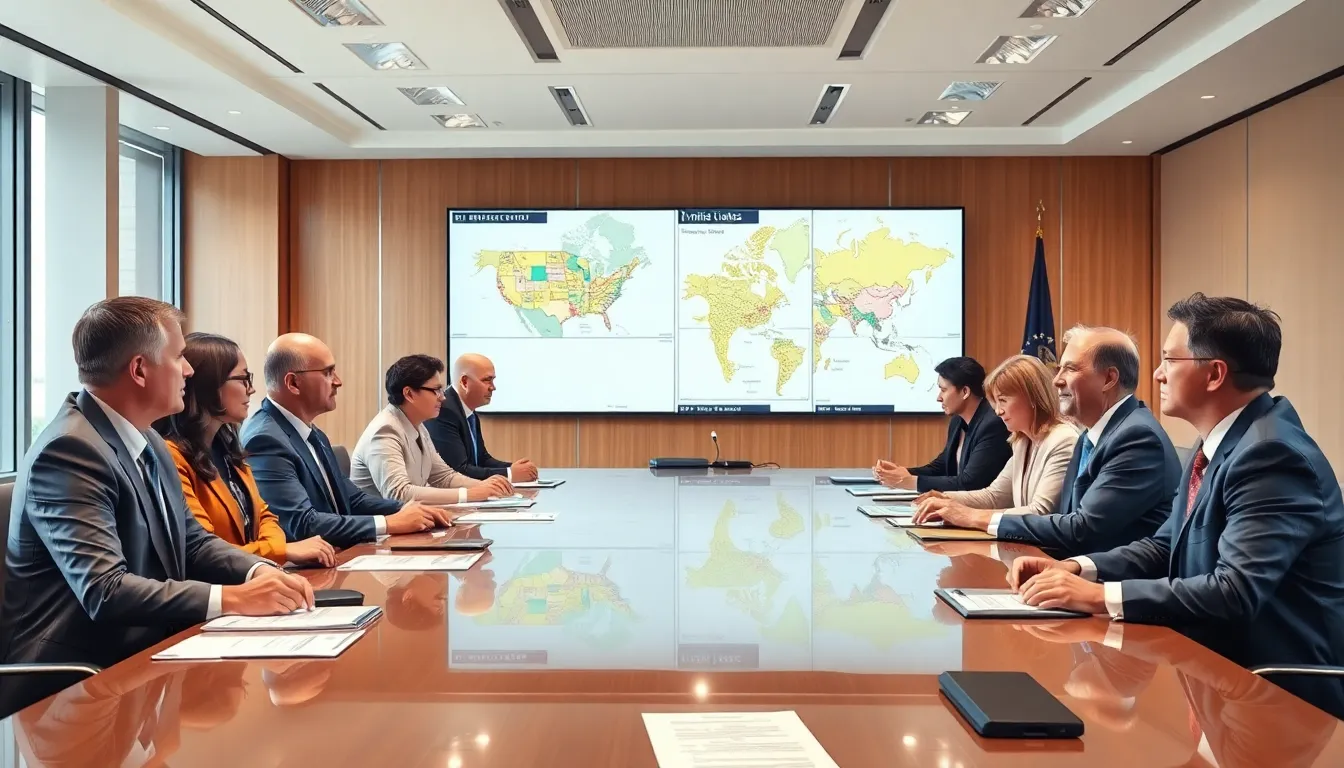In an increasingly unpredictable world, global resilience strategies are more crucial than ever. Nations, communities, and organizations face a myriad of challenges, from climate change to economic instability. These strategies focus on enhancing adaptability and preparedness, ensuring that societies can withstand and recover from disruptions.
As the landscape of risks evolves, innovative approaches to resilience are emerging. By leveraging technology, fostering collaboration, and promoting sustainable practices, entities can build a robust framework to tackle future uncertainties. Understanding these strategies not only empowers decision-makers but also inspires individuals to contribute to a more resilient global community.
Table of Contents
ToggleUnderstanding Global Resilience Strategies
Global resilience strategies refer to structured approaches that enhance the ability of communities and systems to withstand and recover from various disruptions. These strategies play a crucial role in navigating uncertainties from climate change, economic fluctuations, and other global challenges.
Definition and Importance
Global resilience strategies encompass methods that strengthen societal, economic, and environmental systems against risks. These approaches emphasize the significance of resilience in mitigating the impacts of disasters and promoting recovery. By fostering stability, societies can reduce vulnerability and enhance overall wellbeing. Implementing resilience strategies aids in adapting to unforeseen changes, ensuring long-term sustainability.
Key Components
Adaptability: Resilience hinges on flexible systems that can adjust to changing circumstances, whether caused by natural disasters or socio-economic shifts.
Collaboration: Partnerships between governments, businesses, non-profits, and communities foster a collective response to challenges, enhancing resources and expertise available to mitigate risks.
Innovation: Embracing technological advancements enables smarter solutions for anticipating and responding to potential disruptions, improving recovery times and efficiencies.
Sustainability: Integrating sustainable practices ensures that resources remain available for future generations, strengthening community resilience against environmental degradation.
Education and Awareness: Increasing knowledge about risks and preparedness measures equips individuals and communities to respond effectively during crises.
Monitoring: Regular assessment of risks and vulnerabilities enhances proactive measures, helping decision-makers refine resilience strategies based on current data and trends.
The Role of Governments

Governments play a crucial role in developing and implementing global resilience strategies. Their policies shape the infrastructure that supports community resilience against various risks.
Policy Frameworks
Governments establish comprehensive policy frameworks to enhance resilience. These frameworks outline strategic goals, guidelines, and regulations that foster preparedness. For example, policies may focus on climate adaptation, disaster management, and infrastructure development. Integrated planning across sectors encourages collaboration, ensuring that efforts align with local, regional, and national objectives. Regular assessments of policy effectiveness help governments adjust strategies based on changing circumstances.
Funding and Support
Governments allocate funding and resources to support resilience initiatives. Financial investments in infrastructure, education, and technology enhance community preparedness. Public-private partnerships often provide additional funding sources, enabling innovative projects that might not receive government funding alone. Grants and incentives encourage local governments and organizations to implement resilience strategies. Continuous monitoring of funding outcomes ensures that resources are effectively addressing vulnerabilities and improving overall community resilience.
Community Involvement
Community involvement plays a critical role in enhancing global resilience strategies. Engaging local populations fosters a sense of ownership and encourages active participation, leading to more effective and sustainable solutions.
Grassroots Initiatives
Grassroots initiatives empower individuals at the community level to drive change. These initiatives often address specific local needs and leverage existing resources. Examples include community gardens that enhance food security, neighborhood watch programs that improve safety, and local clean-up events that promote environmental stewardship. By fostering collaboration among community members, grassroots initiatives create a network of support that strengthens resilience against various challenges.
Public-Private Partnerships
Public-private partnerships (PPPs) facilitate collaboration between government entities and private organizations, enhancing the capacity for effective resilience strategies. These partnerships combine resources, expertise, and innovative solutions to tackle complex problems. For instance, PPPs can lead to the development of sustainable infrastructure, such as renewable energy projects and efficient transportation systems. They also enable funding for community programs focused on disaster preparedness and economic recovery, ensuring that diverse perspectives contribute to resilience efforts.
Case Studies of Successful Strategies
Examining case studies reveals the effectiveness of global resilience strategies in various contexts. These examples illustrate how different countries and communities navigate challenges through innovative approaches.
Country-Specific Examples
- Netherlands: The Dutch implement advanced water management systems to combat rising sea levels. Innovative barriers and dikes protect low-lying areas from flooding, showing how proactive infrastructure planning enhances resilience against climate change.
- Japan: Japan’s earthquake preparedness strategy includes stringent building codes and regular disaster drills. These measures significantly minimize damage and loss of life during seismic events, demonstrating the effectiveness of community preparedness and government regulations.
- Costa Rica: Costa Rica invests in reforestation and sustainable agriculture practices to combat climate change. This approach not only fosters biodiversity but also strengthens the economy, exemplifying how environmental sustainability contributes to resilience.
- Singapore: Singapore employs smart city technology to monitor and manage urban challenges. Data-driven insights optimize resource allocation and disaster response, showcasing the role of technology in enhancing urban resilience.
Lessons Learned
- Importance of Adaptability: Strategies must evolve with emerging challenges and technologies. Continuous iteration ensures resilience measures remain effective.
- Need for Collaboration: Partnership among government agencies, private sectors, and communities leads to comprehensive solutions. This collaboration enhances resource sharing and knowledge transfer.
- Value of Local Engagement: Involving community members fosters ownership of resilience strategies. Engaged populations often create tailored solutions addressing local needs effectively.
- Significance of Education and Awareness: Ongoing education equips communities with the knowledge to implement resilience strategies. Raising awareness on potential risks enables proactive preparedness.
- Integration of Technology: Utilizing technology enhances data collection and analysis for more informed decision-making. Innovative tech applications provide critical insights for immediate and long-term strategies.
Challenges and Barriers
Global resilience strategies face numerous challenges and barriers that can impede effective implementation. Identifying and addressing these obstacles is crucial for fostering resilience in communities worldwide.
Economic Constraints
Economic constraints significantly hinder the development and implementation of resilience strategies. Limited financial resources restrict investments in infrastructure and sustainable practices. Many communities lack the funding necessary to upgrade existing systems or adopt new technologies. High costs associated with disaster preparedness, recovery, and maintenance can overwhelm local budgets. Insufficient economic diversification leaves communities vulnerable to market fluctuations, further complicating their resilience efforts. Governments must prioritize funding allocation to enhance community preparedness and ensure effective risk management.
Social and Cultural Factors
Social and cultural factors play a pivotal role in shaping community resilience and can both enhance and hinder these strategies. Diverse cultural practices and beliefs may create resistance to certain resilience initiatives, complicating engagement efforts. Additionally, socioeconomic disparities can limit access to information and resources, affecting overall participation. Communities with fragmented social structures often face challenges in fostering collaboration, leading to ineffective communication and decision-making. To overcome these barriers, it’s essential to promote inclusivity and actively involve all community members, ensuring that resilience strategies reflect the unique needs and values of the population.
Global resilience strategies are essential for navigating the complexities of today’s world. By fostering adaptability and collaboration, communities can better prepare for and recover from disruptions. Engaging local populations and leveraging technology are vital components that enhance these strategies, ensuring they address unique challenges effectively.
Governments play a crucial role in shaping policies that support resilience, but community involvement is equally important. Grassroots initiatives empower individuals and create sustainable solutions tailored to local needs. As global challenges continue to evolve, embracing innovative approaches and promoting inclusivity will be key to building a more resilient future for all.




